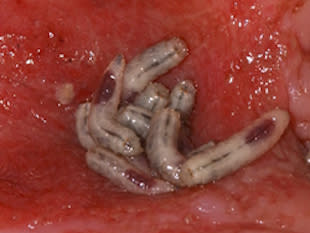 The Sideshow
The SideshowThe healing power of maggot slime

Maggot slime and healing balm are not usually associated with each other. But ScienceNOW reports there's growing evidence that maggots not only help remove necrotic flesh, but also that their excretions can reduce inflammation by suppressing the immune system.
Maggot therapy works essentially by having the larvae consume infected and necrotic flesh while largely ignoring healthy tissue. Of course, patients are discouraged from attempting the treatment on their own, as it can lead to uncontrolled maggot infestations and infections.
The research was published in the latest issue of Wound Repair and Regeneration. In their work, Dr. Gwendolyn Cazander of Leiden University Medical Center in the Netherlands and her team tested the effects of maggot secretion.
They deposited the secretions into donated human blood samples and found that the samples contained lower levels of complement proteins. They also found that the maggot secretions were highly durable, even increasing in effectiveness after being boiled.
"This research advances our understanding of how and why maggot therapy helps wounds heal faster," Ronald Sherman, a pioneering maggot researcher and chair of the Bio Therapeutics, Education & Research Foundation, told ScienceNOW.
As ScienceNOW points out, maggots have been part of the medicinal world for centuries. For example, doctors in Napoleon's army used them to treat the wounds of injured soldiers. After the invention of penicillin, the use of maggot therapy largely tapered off. But in 1989, the practice began making a comeback when Sherman established fly-breeding facilities at the Veterans Affairs Medical Center in California.
In 2004, the U.S. Food and Drug Administration approved maggot debridement therapy as a prescription treatment.
Any form of clinical treatment is at least several years away.


